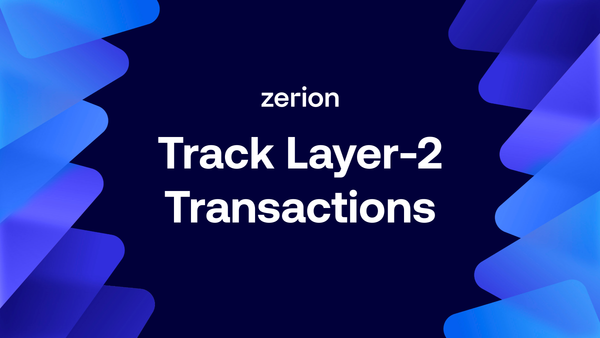The fastest and easiest way to track your Layer-2 transactions is with Zerion.
It’s easy because you connect your wallet or paste your address into Zerion and instantly see all your transaction history across all major Layer-2 networks. It’s also the fastest because you don’t need to open several blockchain explorers for each Layer-2 chain Zerion supports 50+ chains, requires no technical setup, and brings the comprehensive data to a single interface. Zerion helps you to always know exactly what’s happening on Layer-2.
But let’s add some context. If you’re reading this, you’re probably curious about what’s actually going on under the hood.
Understanding Layer-2 Transactions
What Are Layer-2 Solutions?
Layer-2 networks are blockchains built on top of main networks (like Ethereum) to solve the age-old crypto problem: speed and cost. Instead of every transaction going straight to Ethereum mainnet (Layer-1), Layer-2s batch or bundle them together off-chain or in a separate environment, then periodically settle on mainnet. The result? Cheaper, faster, and more scalable transactions. According to Vitalik Buterin, L2s have already scaled Ethereum’s capacity by a factor of 17x and decreased fees by a similar amount.
Layer-2 transactions are processed in bulk and then “anchored” to Layer-1. So, while you might pay pennies and wait seconds on Layer-2, your transaction’s ultimate security still comes from the underlying Layer-1 blockchain. The mechanics can vary by solution.
Types of Layer-2 Solutions
The world of Layer-2 isn’t one-size-fits-all. Here’s how the major types break down:
Rollups (Optimistic and ZK)
Rollups bundle hundreds (or thousands) of transactions off-chain, then post compressed data to the mainnet. This is currently the most popular type of Layer-2 networks. In turn, there are two kinds of rollups:
- Optimistic Rollups (like Optimism): Assume transactions are valid but incorporate a 'fraud proof' period, allowing a window for external validation and challenge by network participants before finalization on Layer-1, balancing efficiency with security.
- ZK Rollups (like zkSync or Zero Network): Leverage advanced zero-knowledge cryptography to generate concise, irrefutable proofs of transaction validity off-chain. These proofs are then posted to Layer-1, ensuring immediate and cryptographic certainty of transaction integrity without revealing underlying data.
Rollups differ in confirmation times, proof mechanisms, and how quickly you can withdraw funds back to mainnet, but both radically reduce transaction costs.
There are also other types of L2 transactions beyond rollups.
State Channels
State channels let users transact off-chain as many times as they want, then settle the final result on Layer-1. It’s like keeping a tab with a friend and only settling up at the end. This approach is blazing fast, but you have to “open” and “close” channels on-chain, which adds a bit of friction.
Sidechains and Plasma
Sidechains are independent blockchains that interact with the mainnet via bridges. Plasma chains bundle transactions and submit them in groups. Security and validation are handled differently, and you typically need to follow special procedures (like exit proofs) to move assets back to mainnet.
Validium
Validium combines data availability solutions and zero-knowledge proofs—so not all data is stored on-chain, but validity is cryptographically proven. This can increase privacy but adds complexity to tracking.
Tools for Tracking Layer-2 Transactions
There are 3 main ways to track Layer-2 transactions:
- Block explorers for individual chains, e.g. Arbiscan for Arbitrum
- A portfolio tracker like Zerion
- APIs that cover Layer-2 transactions, e.g. Zerion API
Block Explorers for Layer-2 Networks
Every Layer-2 has its own “block explorer” (like Etherscan for Ethereum), tailored to its architecture.
- On Polygon, you’ve got Polygonscan.
- On Optimism, there’s Optimistic Etherscan.
- On Arbitrum, there’s Arbiscan.
These explorers let you search transactions by address, hash, or block number. You can see confirmation status, transaction details, and, in many cases, how your Layer-2 proofs link back to Layer-1.
However, block explorers can be too technical. They often give too much information that a regular, non-developer user might not need.
Also if you want to track several Layer-2 networks, you’ll need to use a separate explorer for each chain.
That’s where portfolio trackers come in.
Portfolio and Wallet Tracking Tools
If you’re active across multiple Layer-2s, jumping between explorers gets old fast. That’s where tools like Zerion shines.
Zerion tracks your entire wallet across all chains in one unified dashboard. Just search your address, and Zerion aggregates all your swaps, mints, DeFi activity, and more, whether it’s on Ethereum, Polygon, Optimism, Arbitrum, zkSync, or others.
In fact, Zerion is more than just a portfolio tracker. It’s also a wallet that you can use to transact on 50+ chains, including all popular Layer-2 networks.
For power users, there are also APIs (like the Zerion API!) and developer tools for querying transaction data, monitoring wallets, setting up alerts, and even building custom dashboards.
APIs
With tools like Zerion API, you can fetch all Layer-2 transactions in one call. All you need to do is to get a dev key and then call the wallet's transactions endpoint for a specified address.
Here is an example of a call:
curl --request GET \
--url 'https://api.zerion.io/v1/wallets/0x42b9dF65B219B3dD36FF330A4dD8f327A6Ada990/transactions/?currency=usd&page[size]=100&filter[trash]=no_filter' \
--header 'accept: application/json' \
--header 'authorization: Basic emtfZGV2X2Q2YmEzYzM3NTNiYjQ2NWM4YjNjZTEzMTU2OTVlYjMwOg=='And here is a small part of the data you would get:
{
"type": "transactions",
"id": "a487e0801f055c0193d3fde90b285353",
"attributes": {
"operation_type": "trade",
"hash": "0xc90689ab025928b681b91736b8f12396670594f709c5c31007ce3a1fd945a9ae",
"mined_at_block": 31961023,
"mined_at": "2025-06-23T20:43:13Z",
"sent_from": "0x42b9df65b219b3dd36ff330a4dd8f327a6ada990",
"sent_to": "0xd7f1dd5d49206349cae8b585fcb0ce3d96f1696f",
"status": "confirmed",
"nonce": 897,
"fee": {
"fungible_info": {
"name": "Ethereum",
"symbol": "ETH",
"icon": {
"url": "https://cdn.zerion.io/eth.png"
},
"flags": {
"verified": true
},
To conclude
Want to track your Layer-2 transactions? Use Zerion.
It’s the fastest way to see your complete history across Layer-2 networks—without the headaches. If you want to dig into the nitty gritty (or build your own tools), there is also Zerion API, which can fetch transactions from all major L2 networks.
Ready to see your Layer-2 activity in one place? Try Zerion now.

